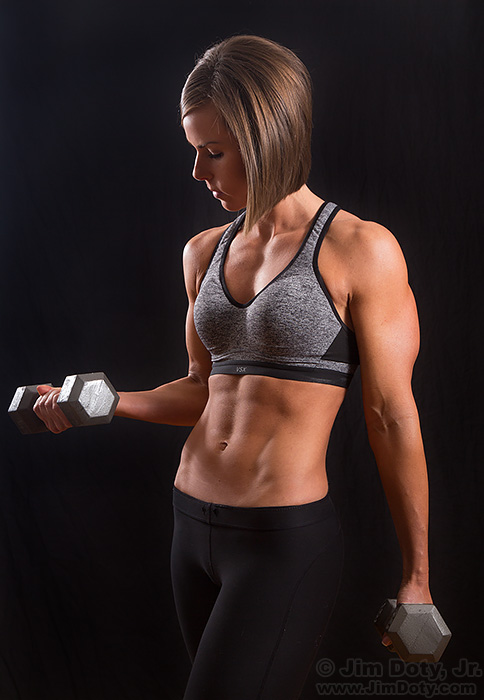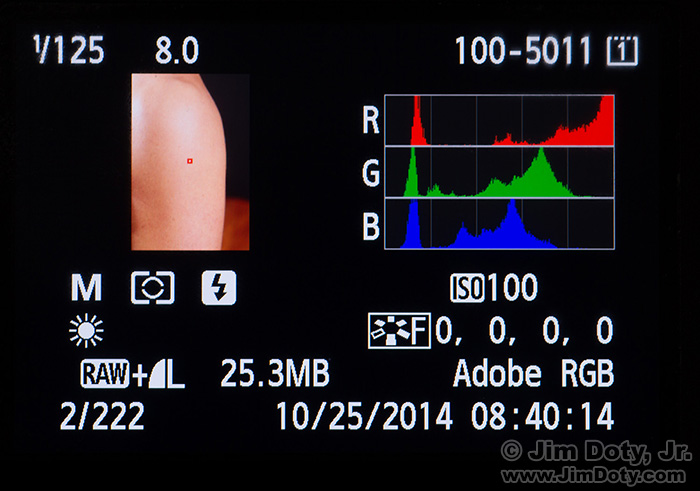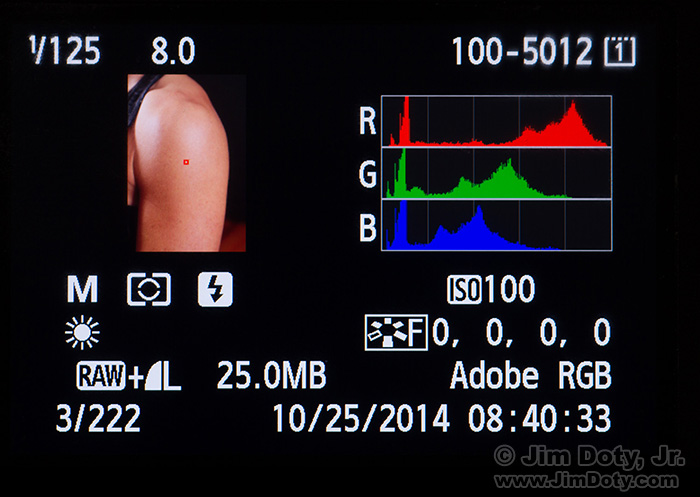When using studio flash units, usually the best way to check your exposures is to use an incident light meter which is capable of metering flash exposures. But what if you don’t have an incident flash meter? Or what if you have a subject that absorbs a lot of light? Or a subject that reflects a lot more light than your typical photographic subject? You can double check your exposure settings by using the histogram on your camera. FYI: Do not trust the LCD image on the back of your camera to judge your exposures.
The secret to a reliable histogram is to zoom in close to your subject (so the histogram isn’t unduly influenced by the background). Pick a known tonality to photograph and take a picture. If you are doing people pictures the tonality to photograph is human skin. Then check the histogram. In this case I zoomed in on Sarah’s shoulder, took a picture and looked at the histogram. Notice all the red pixels bunched up against the right edge of the histogram. That is a bad thing. That means I have burned out red pixels in the photo so this photo is overexposed. The green and blue channels are fine.
I dialed down the power settings on the back of the studio flash units and took another closeup of Sarah’s shoulder. There are no pixels bunched up against the right edge of the histogram, so there are no burned out pixels in this image. That is a good thing. Sarah’s skin is one stop lighter than a medium tone so we should expect the majority of the red pixels to be shifted toward the right side of the histogram. That is just where they are so we have a good exposure. If I was photographing a person with darker skin tones, the bulk of the red pixels should not be shifted so far to the right.
Note that the camera settings for both images are the same (1/125 at f/8). I reduced the light output on the studio flashes to get a good histogram. I could have left the studio flash unchanged and used a smaller aperture on the camera lens to get a good histogram.
Now that I have confirmed the right exposure settings I can go on with the photo shoot and my exposures will be great. As in all flash photography, thanks to light fall off the intensity of the light output of the flash units varies with the distance to the subject. If you change the flash to subject distance during the photo shoot, you will need to change the power output of the studio flashes accordingly, and check the exposure again.
Do not trust the LCD image on the back of your camera when judging exposures. Why? Because the brightness of the LCD image is determined by the brightness settings for the LCD, not the exposure of the image.
Originally posted November 10, 2015. Revised and re-posted November 21, 1017.
Article Links: Off-Camera Flash Series
“How To†Series: Off-Camera Flash – Series Introduction
Some of the Best Off-Camera Flash Equipment
Radio Controlled Speedlites: Yongnuo YN600EX-RT vs Canon 600EX-RT
Light Modifiers (Softeners) for Speedlites
Putting Together a “Studio in a Backpackâ€. Everything you need to take a small, portable portrait studio on the road. And you may have some of the items already.
How To Set Up a Halo Softbox or Umbrella with an Off-Camera Speedlite
Photo Shoot: Using a Halo Softbox with a Yongnuo Radio Controlled Flash System
Environmental Portraits and Off-Camera Flash, Part 1
Environmental Portraits and Off-Camera Flash, Part 2
Environmental Portraits and Off-Camera Flash, Part 3
AlienBees: High Quality, Economical Studio Lights
Using the Histogram to Check Studio Flash Exposures
More Links
To learn more about portrait photography, flash photography, studio flash units, flash power settings, light fall off, f-stops, and a whole lot more, read Digital Photography Exposure for Dummies. It is one of the highest rated photography books at Amazon.com. Learn more here and order if from one of Amazon’s third party sellers.



